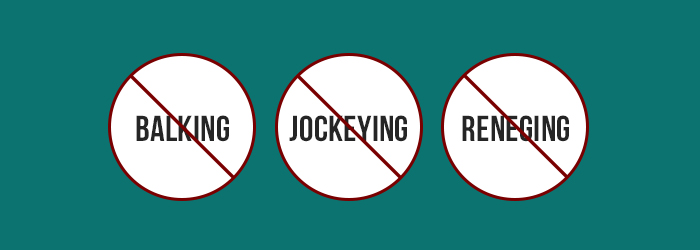
How to Prevent Balking, Jockeying and Reneging in Your Waiting Lines
When it comes to waiting lines, and any queuing system for that matter, we look for ways to understand why lines form and what the waiting times may be, and to determine how many service agents or cashiers are needed to adequately handle the inflow. The overarching goal of queue management is to improve the customer experience while minimizing the cost for servicing the inflow of customers.
This goal can be achieved by studying the customer’s waiting time before receiving service, the length of the queue, and the number of customers in the entire system, and then providing an adequate number of service channels to ensure that the servers remain reasonably busy. To be effective, the system needs to maintain a certain level of customer throughput to avoid congestion and to minimize customer’s discomfort.
That’s the theoretical side of queuing. But let’s consider the more practical side. Specifically, what happens when there’s an upset in the balance of customers waiting and service capacity. This is when long lines form, customer frustrations rise, and customers can be lost. 3 common reactions can occur when the balance between customers and service capacity is overthrown:
- A customer may decide that the queue is too long and leave, or balk.
- A customer may enter the queue, but become impatient and leave, behavior known as reneging.
- Or, as it often happens in supermarkets, a customer may move, or jockey, from a seemingly longer queue to a shorter one or the one with customers whose shopping carts are lightly loaded.
Let’s look at each of these responses in turn and strategies you can use to prevent customer loss and frustration:
Balking: “I’m not going to wait in that line.”
Customers dislike the appearance of a long, snaking line. Disney understands this all too well, which is why they hide the length of their lines through many twists, turns, and hidden sections. When a customer decides not to enter the waiting line at all, it’s called balking. And balking is something most all businesses would like to prevent.
The solution to balking is not a simple one. Instead it requires a holistic approach to queue management that sends the right signals to customers that (a) they won’t be waiting too long; (b) you have the right staffing in place to address their needs as quickly as possible; (c) they are in the shortest possible line; and (d) the result will be worth the wait!
Here are a few tips to reduce balking:
- Publish estimated wait times: Known waits feel shorter than unknown waits and since customers tend to overestimate how long they’ve been waiting, it’s best to publish accurate estimates right up front.
- Consider virtual queuing: Have you thought about ridding your queue of its physical waiting line? Virtual queuing systems allow customers to ‘check in’ to your queue via a kiosk or mobile app and be called to service when it’s their turn. No waiting line required.
- Monitor your queues in real time: Use a footfall analytics system to keep tabs on exactly how many people are in line now, how many service agents are available to help, and how long the wait time is and will be soon. With this data at your fingertips you can proactively manage waiting lines, open new lines as needed, direct customers to open lines, and head off problems before they get out of hand.
Jockeying: “Hey, that line looks like it’s moving faster.”
Jockeying, or moving from one queue to another, can occur because customers feel they have chosen the ‘wrong (slower) line’ but it can also occur because the wait feels unfair. Perhaps they’ve just had someone cut in line ahead of them or their line has a slow cashier or a customer ahead of them is performing a lengthy, complicated transaction. When the customer enters one line and then switches to a different one, the reason is clear. They want to shorten their wait time.
The easiest, most sure-fire way to remove jockeying and the stress that accompanies it, is to employ a single line queue. A recent BusinessInsider article, Why You’re Drawn to Slower Checkout Lines, points out there's a reason people always feel like they chose the wrong line in a multiple line environment. The reason is, “the mathematical odds are stacked against you when you're trying to pick the fastest of more than two lines.”
There is just too much variation in the time a customer can end up waiting. For example, in a three-line, three-register environment, the probability an individual will be in the fastest line is only one in three. Additionally, the gap between the shortest and the longest wait is usually an extremely unfair spread. A single line queue, on the other hand, removes the variability and is proven to result in lower average wait times along with instilling fairness in the queue since everyone is served on a first-come, first-served basis.
Reneging: “I’m outta here.”
A sorry sight for any business is a customer who enters, then leaves the waiting line before being served. Talk about a lost opportunity. Research has shown that, on average, people overestimate how long they’ve been waiting in a line by about 36%. This is a big contributor to reneging but it’s not the only one. Consider these common reasons for reneging and prevention tips:
- Customers need to be engaged while they wait. Boredom makes time go by more slowly and leads people to want to get out of line. Engage customers with in queue merchandising and/or entertainment via digital signage.
- Customers who see that the checkout process is being actively managed are more willing to wait. Use footfall analytics with real-time alerts to know when wait times are in jeopardy of falling outside acceptable limits and act accordingly.
- A slow-moving line is ripe for reneging. Keep things moving forward. Ramp up efficiency and improve wait times and service rates by incorporating automation into your queue. One way is to automate the call-forward process, eliminating the need for service agents to manually press a button or yell to the next customer in line.
Balking and Jockeying and reneging, oh my! Let the tips above help prevent frustration and the loss of customers.
SUBSCRIBE
Subscribe to stay up-to-date with new products, resources information and news.
RECENT RESOURCES
4 Psychological Reasons Your Customers Hate Waiting In Line
ViewFrom Bleachers To Bookstores: 4 Campus Crowd Control Solutions
ViewCrowd Control Systems for Large Venues
ViewWrigley Field Case Study: Just Walk Out Technology
View








